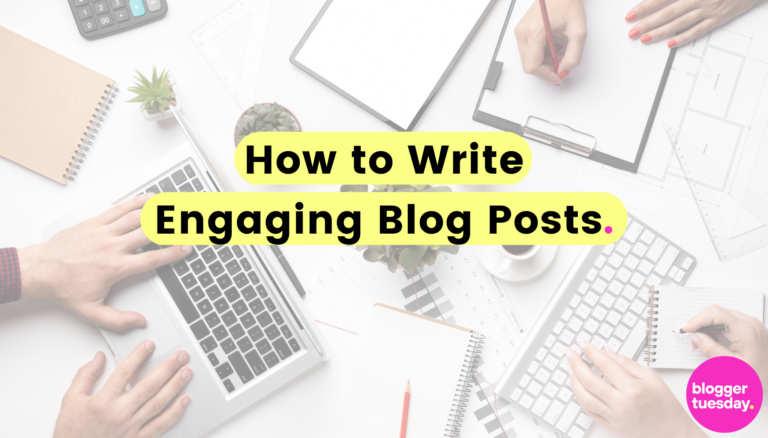Blogging has become an increasingly popular way to share ideas and connect with people online. Whether you’re a seasoned blogger or just starting out, creating engaging content is essential to building a loyal audience. Here are some tips on how to write engaging blog posts.
- Start with a catchy headline.
The headline is one of the most important parts of your blog post. It’s the first thing readers will see and it needs to grab their attention. To choose a catchy headline, consider the main message or point of your post and try to sum it up in a clear and concise way. Use attention-grabbing adjectives and action words, ask a question, or make a bold statement. Consider using numbers or asking a thought-provoking question to intrigue readers. Finally, make sure your headline accurately reflects the content of your post and is SEO-friendly.
Fun fact: 80% of people will read a title, but only 20% of people will actually read the article. [source]
- Use a conversational tone.
Using a conversational tone in your blog posts can help you connect with your readers on a personal level
. Writing as if you are having a conversation with a friend can make your content more engaging and relatable. It also allows you to inject some personality and humour into your writing, making it more enjoyable to read. Avoid using overly formal language or jargon that may alienate your readers. Instead, aim for a tone that is approachable, friendly, and easy to understand. This can help build trust and credibility with your audience, leading to a more loyal following.
Fun fact: 247% more readers consume a full article when written in a conversational tone [source]
- Focus on your reader.
Focusing on your reader is essential when writing a blog post. It’s important to understand who your target audience is and what their interests, questions, and concerns are. By addressing these, you can create content that resonates with your readers and keeps them engaged. Use language that is familiar and accessible to your audience, and avoid using overly technical terms or jargon. Address your readers directly and ask questions that encourage interaction and feedback. Consider providing value to your readers by answering their questions or providing helpful tips and advice. This can help build a relationship of trust and loyalty with your audience.
Fun fact: 55% of people will spend less than 15 seconds reading a blog post [source]
- Use visuals
Using visuals in your blog post can enhance the reader’s experience and improve engagement. It can help break up lengthy blocks of text and make complex information easier to understand. Use high-quality images, videos, and infographics to illustrate your points and add visual interest to your post. Visuals can also help reinforce your brand and make your content more memorable. Consider optimizing your images for web use to ensure fast loading times and use alt text to describe your images for accessibility and SEO purposes. Incorporating visuals into your blog post can help increase readability and keep readers interested.
Fun fact: Posts with images produce 650% higher engagement than text-only posts. [source]
- Tell a story
People love stories, and incorporating storytelling into your blog posts can make them more engaging and memorable. Whether it’s a personal anecdote or a case study, use storytelling to bring your ideas to life and create a connection with your readers. Make sure your story has a clear beginning, middle, and end, and use descriptive language to help your readers visualise what’s happening.
Fun fact: stories are 22 times more memorable than bare facts. [source]
- Keep it concise
Keeping your blog post concise is crucial to holding your reader’s attention. Long, rambling paragraphs can quickly lose a reader’s interest. Instead, aim to keep your sentences and paragraphs short and to the point. Use subheadings to break up your content into smaller, more digestible chunks. Make every word count and avoid unnecessary repetition or filler. Get to the point quickly and provide valuable information without being overly wordy. This will help keep your readers engaged and make your content more memorable. Remember, brevity is key when it comes to blog writing.
Fun fact: On the average Web page, users have time to read at most 28 percent of the words during an average visit; 20 percent is more likely. [source]
- Use subheadings
Using subheadings in your blog post can improve the structure and readability of your content. They can help break up long blocks of text and make it easier for readers to scan and find the information they’re looking for. Use descriptive and informative subheadings that accurately reflect the content of each section. This can help guide your reader through your post and keep them engaged. Subheadings can also help with SEO by providing additional context and structure to your content. Incorporating subheadings into your blog post can improve its overall quality and make it more user-friendly.
Fun fact: 67.5% of screen reader users navigate pages using headings. [source]
- Provide value
Providing value to your readers is essential for creating engaging and successful blog posts. Consider what questions, concerns, or interests your target audience may have and provide informative and useful content that addresses these. Offer actionable tips, advice, or solutions that your readers can apply to their own lives. Providing unique and valuable insights can help set you apart from other bloggers in your niche and establish you as an authority in your field. Make sure to stay up to date with the latest trends and developments in your industry and provide timely and relevant information to your readers. Providing value can help build trust, loyalty, and engagement with your audience.
Fun fact: 61% of consumers’ buying decisions are influenced by custom content [source]
9. Edit and proofread
Proofreading your blog post is essential to ensure its quality and readability. It can help you catch spelling and grammar errors, awkward phrasing, and inconsistencies in tone and style. Take a break from writing and come back to your post with fresh eyes to spot mistakes you may have missed before. Consider using tools like grammar and spell checkers to help with the process. Read your post out loud to check for flow and readability. Have someone else read your post and provide feedback. Proofreading can improve the overall quality of your post and make it more enjoyable for readers to read.
Fun fact: 54% of employers would think twice about hiring you if you make spelling and grammar mistakes in your Tweets and posts [source]
- Engage with your readers.
Engaging with your readers is essential for building a loyal following and creating a community around your blog. Respond to comments and questions from your readers and encourage interaction through calls to action and questions. Consider creating social media accounts for your blog to connect with your audience and share your content. Respond to messages and comments on social media in a timely and friendly manner. Consider hosting giveaways or contests to encourage engagement and reward loyal readers. Engaging with your readers can help build trust and loyalty, and encourage them to share your content with their own followers.
Fun fact: 70% of consumers prefer learning about a company from a blog post to an ad. [source]


